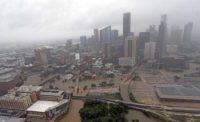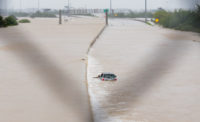As residents across Houston continue the clean-up following Hurricane Harvey, leaders at the local, state and national levels are looking to next steps that will enhance the region’s hurricane and flood resiliency.
In the immediate aftermath of the storm, local construction and design firms prioritized the safety and well-being of their employees before assessing the impact on projects.
Having ridden out 15 hurricanes and tropical storms along the Gulf Coast since 1994, teams at Yates Construction began preparing for the storm days before Harvey’s landfall on Aug. 25. Daily calls and meetings encouraged staff to plan and be safe.
“Fortunately, all of our employees and their families were safe, but a few had their worlds turned upside down and were displaced for a few weeks,” says Randy Powell, Yates’s senior vice president.
Yates’s jobsites in Gregory, Corpus Christi and Houston suffered only minor damage, and within a week after the storm, teams were back on site, thanks to pre-storm preparations.
“When Harvey hit, Yates’s local hurricane response team immediately mobilized to the greater Houston area to assess the damage and assist a private manufacturing client in Victoria, arriving on site within hours of receiving the call,” Powell says. “We completed a safety and damage assessment and began recovery efforts. What followed were 12-hour days, seven days per week, until we successfully mitigated the water damage.”
In the weeks that followed the storm, Yates has been asked to assess and potentially remediate, repair or rebuild 10 additional buildings damaged by Harvey for another private client on a manufacturing campus in Seadrift.
When Harvey flooded Houston’s Northeast Water Purification Plant, emergency response efforts helped keep the plant online, despite parts of it being under water.
AECOM, the lead engineer and emergency coordinator to the city, guided the recovery and operation of Houston’s water and wastewater infrastructure.
The firm oversaw the task of pumping out city hall and other city facilities that had been inundated by the flood. AECOM also led the immediate recovery and emergency damage assessment of city water and wastewater facilities, including treatment plants and pump stations.
Project Impacts
“All of our projects in the Houston area were impacted to some extent,” says Gilbane Building Co.’s senior vice president Dan Gilbane. “We had one project in the downtown area that was probably out of service for about a week and took on significant water, but we were able to get the water out and are working through remediation,” he says.
“We have a safety plan for each project, and they all include storm response, particularly as it relates to hurricanes. So, we were pretty fortunate that we could just put those plans in place and react to things as they came in.”
In Corpus Christi, south of where Harvey made landfall, McCarthy Building Cos. is working on a $270-million hospital expansion for CHRISTUS Spohn, which also made it through the storm intact.
“We had two tower cranes up there next to the tower that we’re building that was nearly topped out at the time,” explains Vice President of Operations Ben Johanneman. “We were able to get our tower cranes tied back to the new structure that we had built and reinforced them for the hurricane force winds, which withstood the hurricane just fine.”
A “ride-out team” comprised of about 15 salaried and craft employees stayed on site for two nights during the storm to help with potential problems. The team ended up helping with hospital functions more than anything associated with the project, Johanneman says.
Assessments Ahead
A critical factor in the short and long-term recovery following this year’s hurricane season is the demand for construction labor and materials, and its impact on the industry as a whole.
“Prior to both of these storms hitting, the market was already busy,” Powell says. “So far, our subcontractors, suppliers and vendors have been able to meet the demand for initial repair products after the storms including drywall, roofing, insulation and other building materials, but now it’s a wait-and-see approach as it relates to material prices.”
Prices have increased three to six months after major storms like this in the past, he notes, but with Harvey and Irma arriving back to back, materials-price escalation has become even more of a concern.
The consensus among local firms is that while Harvey was a hugely catastrophic storm across the greater Houston area all the way to Corpus Christi, the flooding had more consequences on the residential side than on major commercial projects.
In early September, Congress passed a $15-billion federal-aid bill for Houston to help with recovery costs.
But infrastructure improvement funding isn’t on the way yet. “In the aftermath of Katrina, the federal government appropriated $16 billion of additional flood control structures to help the future, and all those were built in an expedited fashion in New Orleans. They were massive civil works projects that were delivered very quickly, so they could be ready for the next storm,” notes John Basilica, gulf coast district leader at HNTB.
“I will tell you that the Harvey experience is the closest thing in my professional judgement to Katrina. If you recall the levies that broke in New Orleans, those roads were under water for over 50 days. But Harvey was different from other storms because the storm sat on top of the coastline of Texas, and it was basically four or five days of continuous rain.”
The effects of that type of flooding on infrastructure is significant, and much of it is latent because its affects the road base, Basilica says.
On the west side of Houston, a segment of the Sam Houston Tollway south of Interstate-10 was submerged under nearly 15 ft of water. Pressure from the water heaved five lanes of pavement and degraded the base on the southbound lanes. Crews completed repairs on a 350-ft by 60-ft area of pavement in just five days.
Webber LLC went to work helping Southern Crushed Concrete with that repair for the Harris County Toll Road Authority, and helped both HCTRA and the Texas Dept. of Transportation in repairing other roadways across the city.
“Immediately after flood waters began to recede, our employees began collaborating on the best way to help other affected employees and their communities. From going into homes to tear out drywall to a donation program directly benefitting impacted employees, matched 2:1 by Webber and our parent company Ferrovial Agroman, our company has stepped up in these trying few weeks,” says Tim Creson, Webber’s president and CEO. “In the end, the effects of the hurricane and our collective efforts to mitigate its damages will result in a multimillion dollar impact to our business. But I’m proud of the fact that we took care of our clients and employees in these trying times.”
At this point, agencies are now focusing on developing procurements in order to get firms on contract, Basilica explains.
No major infrastructure improvements to help with storm surge or mitigating flood risks have been put in place since Hurricane Ike struck in 2008. Houstonians endured the Memorial Day Flood in 2015, followed by the Tax Day Floods in 2016, both of which were catastrophic, and no projects were approved in the aftermath of those storms either.
Hydrologists and land-use experts at Rice University and Texas A&M University at Galveston published a study just days before Hurricane Harvey that examined flood claims in several southeastern Houston suburbs from 1999 to 2009. Researchers discovered that the Federal Emergency Management Agency’s 100-year flood plain maps failed to capture 75% of flood damages from five serious floods, none of which even reached the threshold of a 100-year event.
The Houston-Galveston region has been and will continue to be vulnerable to the joint flood hazards that come with tropical cyclones near the Gulf Coast, explains Dr. Jacob Torres, senior project engineer with Lockwood, Andrews & Newnam. The firm is working with Rice University’s Severe Storm Prediction, Education and Evacuation from Disasters (SSPEED) Center.
“The question is not will this happen again, but when will this happen again,” Torres says.
In the weeks following Harvey, Houston Mayor Sylvester Turner voiced his support of the Coastal Spine, or Ike Dike. The measure was conceived by Bill Merrell at Texas A&M Galveston in 2009 to protect the Houston-Galveston area from storm surge. The 70-mile, 17-ft-high coastal barrier would cost an estimated $4 billion to $8 billion, but there are no plans to build it. Texas General Land Office Commissioner George P. Bush wrote the White House in April, asking for $15 billion to build a coastal spine system. No response yet, he says.
Researchers at the SSPEED Center also have proposed the Mid-Bay Strategy (MBS), which could work in tandem with the Coastal Spine. It incorporates elements of localized protection and the vulnerable, shrinking coastline with structural barrier systems placed across major tidal inlets and barrier islands. It also includes measures such as wetland restoration and a gate structure across the Houston Ship Channel.
“Modeling of the MBS has shown the Houston Ship Channel and the highly populated west Galveston Bay can be protected from hurricane storm surge, while the immediate upstream portion of the protected MBS side can behave as a retention pond for storing hurricane rainfall-runoff,” Torres explains.
The MBS is still being studied, and an environmental impact study is now underway. Projects under the scope of the MBS are expected to cost about $3 billion but wouldn’t begin construction for at least five years.
Fortunately, Harvey didn’t carry storm surge with it, but had that happened, “there could have been some real devastation in the ship channel, so the issue of protecting the coast itself is an issue,” said Andy Icken, chief development officer, city of Houston, speaking at a Sept. 28 Infrastructure Seminar held by ICEX Export & Investment.
“We have thrown that gauntlet down. We see that given the economic impact of the ship channel itself and all the industries there, [this is] a national issue, and we’re taking that to Washington to talk about doing that,” Icken says.
Although the Coastal Spine could help with immediate threats presented by storm surge—especially since Houston has several bayou systems draining much of the county towards Galveston Bay—“you don’t want to make things worse by protecting [the area] from surge and not considering the rainfall component tropical cyclones can introduce,” Torres adds.
“[We need] more comprehensive regional protection, which is what led the SSPEED Center to propose the MBS.”
As ideas like the Coastal Spine and MBS are finally gaining more momentum, so too are others across the city, such as the concept of a third reservoir in the northwest part of Houston. That would help supplement existing reservoirs Addicks and Barker. Bayou improvement projects also have been discussed.
Icken said that maps showing the impact of Harvey reveal that along Sims Bayou, the southern-most of the major bayous, there was almost no damage. “That was a $500-million project done 20 years ago, [and it] kept that bayou in the banks—that is ultimately the goal of a bayou project,” he says. “I would expect over the next year or two, you’re going to see a whole lot more emphasis on what is needed and speed up processes that have been ongoing.”








Post a comment to this article
Report Abusive Comment